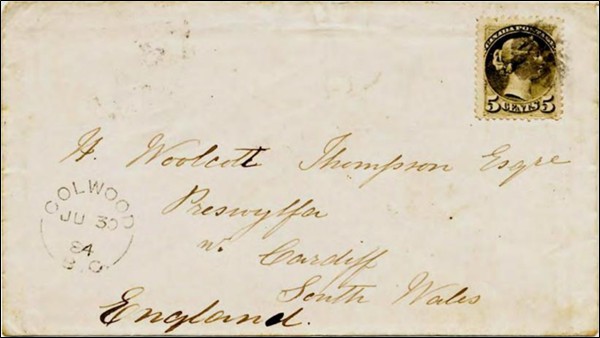A Classic Postmark – The Broken Circle
The Guideline, Journal of the VIPS, December 1985, pp. 4 and 5
by Lester Small
The broken circle will now take its place as a classic postmark with the squared circle. The broken circle is a cancel that has tied the two centuries together. In 1984 a new type of cancellation was introduced into the post office that has threatened to delete the few broken circles still in use in B.C.
A list of all offices that used the broken circle is now being compiled and is a huge job. My interest is solely in B.C., but the following can apply to all of the provinces, Yukon, and the Northwest Territories.
The broken circle is dainty with a charm all its own. It is always a clear, readable strike. A killer was used to cancel the stamp, and the hammer strike was to the left on the envelope, where the town, province, and indicia were clearly shown.
During the years of use, a postal regulation, long since discarded, required a backstamp on each piece of incoming mail.
In 1876 Victoria was a small frontier town, gateway to the interior gold fields. I had two covers from Glasgow addressed to a local citizen. One went into my Great Britain file and the second into a trading box. Curiosity later had me take it out to look at the back. There on the back was my first Victoria broken circle postmark - May 25, 1876. Mailed in Glasgow April 24, 1876 and delivered here May 25, 1876. Please note the fast delivery compared to 1985.
The best way, if possible, is to collect the entire envelope, and this can be quite expensive. Other collectable forms are on piece, bullseye, backslips, red bills, and registration boxes. It is only in these varieties that I can get a strike of some of the old places. So don't ignore them!
The appearance of the broken circle strike can be deceiving. There is a hold type - a short name such as DOT B.C. or a small type as in Halcyon Hot Springs. Some of the last user of these were in the registration branches.
A postmaster that used his hammer with respect had it for the life of his office. Others were lost or damaged as in a fire or a robbery. So a new one had to be ordered. These would not be identical and so one would have different sizes. Union Bay had two - dated August 27 1907 at 20 mm, the other dated Dec 24 1910 with a 19 mm diameter.
In my collection, the hammers seemed to fall into several sizes. Bella Coola dated July 19 1944 is the smallest at 18 mm. The common size for most offices is 20 mm. Beaumont May 19 1909 and Lund Jan 26 1941. Fort St. John- Aug 2 1962; Klemtu May 25 1940; and University Hill Nov 16 1933 all measure 21 mm. Another reason for these variations would be that the hammers were the products of different manufacturers. [All were made by Pritchard Andrews Co. of Ottawa. There were different craftsmen. kgs]
The broken circles are gone. A new classic is crowding to the squared circle. There is a surging demand and no supply. When it was plentiful, nobody was interested. Now there is a demand and it is in short supply.

Colwood, B.C. broken circle postmark dated June 30, 1884. (G. Scrimgeour)